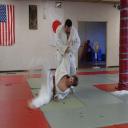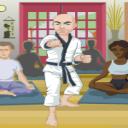Yahoo Answers is shutting down on May 4th, 2021 (Eastern Time) and beginning April 20th, 2021 (Eastern Time) the Yahoo Answers website will be in read-only mode. There will be no changes to other Yahoo properties or services, or your Yahoo account. You can find more information about the Yahoo Answers shutdown and how to download your data on this help page.
Trending News
Judo/BJJ Quiz 1.?
I so much enjoy the great many people who have mentioned how their art contains Judo or BJJ, or many joint locks, or that they have studied BJJ, Judo, MMA, Jointsnappin Jitsu that I figured I would post a few quizzes here to help those who could be potentially interested in grappling arts or new students get some understanding about techniques. I'll make this one fairly basic, something someone with 6 months into the art would know.
1. What are the important things to remember to make a juji gatame (cross body arm lock) work? Key things your instructor will tell you to remember when applying this technique.
2. When doing Ogoshi (or a hip throw) what direction are throwing your opponent? (ie. forward, backward, etc. You can use compass points if you wish)
3. For BJJ/MMA is the achille leg lock a joint lock? What joint does it work on?
4. For BJJ/MMA what are the dangers of applying a heelhook against a lesser experienced training partner?
Wow... 3 hours and only two attempts at an answer? Seriously, where are all the MMA experts? What about the guys who have taken some Judo, claim to be in BJJ, or MMA fighters? Pretty easy questions, let's help some people out guys...
Great job on number 1 and 2 I Hate Lazy People... unfortunately you don't allow messages, so I can't send you my answers...
Everyone else, I have sent messages with feedback about their answers...
Good stuff so far!
Pretty good jwbull... again, I can't message you with feedback like I am doing for those who have that enabled.
Good answers on the first two Mito Sensei, I cant message you the rest of my feedback.. there are some keys to 3 and 4 that are important...
Getting some real good stuff, giving lots of feedback to those with messaging enabled... keep up the good work!
16 Answers
- The Sanda PandaLv 41 decade agoFavorite Answer
1) Make sure that your *** is right up against the other guy's shoulder, so that you're actually doing something to the guy's elbow. Squeeze your knees together and dig the heel against the guy's neck. Make sure that the guy's thumb is pointing up.
2) I'm throwing my opponent forward.
3) Yes, it is a jointlock, but also a compression hold. It compresses the achilles tendon, but can also pop out an ankle, I believe. I could be wrong, but it sure as heck feels that way.
4) The heelhook doesn't hurt that much, unless you actually torque it. If you do, the guy's leg will be rice crispies cereal -- snap, crackle, and pop. Because a newer person might not recognize when they're caught and how dangerous it is, they may try to fight through the relatively light pain, only to get themselves hurt.
So as not to cheat, I didn't look at other people's answers yet.
Really good idea, btw.
- BigfootLv 71 decade ago
1) Knees together, pull your opponents arm in the direction opposite their thumb (preferably keep the thumb up), keep your butt close to their shoulder, elevate your hips. (there's probably more)
2) If you are facing south at the beginning of the throw, an Ogoshi throw is in about the E-NE direction if you are fighting in a right handed position (left hand initiating the pull, right hand on the opponent's back). You are throwing the opponent over your back more to the side than forward.
3) Never used any leglocks (I'm primarily a Judo guy) but I'm going to guess that it's an ankle lock.
4) The ankle is a very fragile joint with a lot of tendons and bones that can be broken very quickly. A heelhook can do tremendous damage very quickly unless your opponent knows how to counteract it. An inexperienced training partner not only won't know where to move to relieve pressure, but they may panic and move in a direction that increases the damage.
EDIT: I re-enabled messaging. Great topic.
- TaoLv 51 decade ago
Gimme 6 months! I'm starting the BJJ training in August - gimme some striking questions and I'll er give it my best shot!
Are you going to give answers / corrections later? Anyway, I'll guess just for fun.
1) I'll guess you want to watch opponent's free arm/hand as well as the angle at which you apply the lock. From watching our grapplers instruction the opponent's thumb should point upwards / away from your body.
2) Not sure - is this the one where you basically twist your body, continuing his momentum, but landing on top? Start of facing north (opponent facing south) and end up facing south, but mounted on opponent?
3) I think this is more of a pain submission. Maybe works on the ankle/calf.
4) Anyone unexperienced / unconditioned can cause themselves great injury by turning the wrong way in a lock/submission situation. Some of the counters are not intuitive (moving into rather than away from the opponent for example) I'm not sure about this but I'm thinking if the opponent twisted into it or reached forward toward you the ligaments in the lower leg/foot could pop pretty easily.
There you have it - 4 wildly uninformed guesses! Looking forward to your next post.
- kangarooLv 41 decade ago
I do trad ju-jitsu, so i may make a few mistakes here, but ill give it a shot...
1. I think this may be like an armbar from the mount? not sure. Anyway, when doing this technique you need to first gain control of one of your attacker's arms. I usually go for the right arm because it's easier to swing round that way. When you have a tight grip on their forearm, elbow their face over to the side and step your left foot over their chest. Then sit back with the arm and bring your knees together while raising your hips slightly off the ground. It's important to be in nice and close to your opponent's shoulder, and to have a good grip on their arm.
2. When I do an ogoshi, the uke is thrown in the same direction as their attack. Not straight ahead though, at an angle to one side. For example, if they attack me straight on with a punch, then I step in and round so that I am facing the same way as them. Then, with my feet inside their stance, a tight grip on the attacking arm, and my right hand around their waist or neck, I bend at the knees to lever them up and then turn to the left to throw them down at my feet. I am then free to apply an armbar or figure 4 or whatever.
3. I would imagine this is an ankle lock to apply pressure to the achilles tendon.
4. Again, I don't do BJJ, but I'd say a technique like this would put a lot of strain on the ligaments in the knee. An inexperienced partner may leave it too late to tap out of it, or may struggle instead, causing serious damage.
- How do you think about the answers? You can sign in to vote the answer.
- Anonymous1 decade ago
Guess I am a little late to this one.
1. I know a few cross arm grabs and some are counters. Keeping the thumb up is key to getting the joint to lock, also want to stay in close for better control.
2. basically foward, maybe at a slight 45 degree angle.
3. Not great on biology, but yes there is a lock down there, but I think it locks the ankle more than achilles.
4. Similar issue with all locks, they may not tap out in time and you might hyper extend the joint. The more experienced person should go slower with the newbie to make sure this doesn't happen.
UPDATE: I can receive feedback now.
Source(s): 15+ Years: Karate, Jujitsu (mostly Japanese), Muay Thai. - 1 decade ago
Knowing absolutely NOTHING about Judo/BJJ, I will now provide the really true actual answers that are so secret that I run the risk of damaging my standing in the Super Secret Judo/BJJ underground:
1. Watch out for your opponents buddy, who may be sneaking up behind you to apply the Super-Deadly Judo Chop to the back of your neck. A REALLY super good opponent can actually apply this technique himself, particularly if he is an accomplished MMA guru who is able to manifest a third arm in a close combat situation (although some of these techniques may sound unbelievable, I swear they are true; a guy I once talked to outside of the community center said his brother's cousin's half-sister saw a guy actually do this in a bar fight, right before the fight went to the ground).
2. I try NOT to throw my hip, because it makes it exceedingly difficult to walk when I do this. If I DO throw my hip, I make sure I have "ground-and-pound'ed" my opponent into unconciousness so that he cannot take advantage of my slightly weakened state.
3. the Achilles Leg Lock ACTUALLY puts pressure on the right elbow joint if applied correctly. this has the effect of TOTALLY confusing your opponent long enough to "ground-and-pound" them after you take the fight to the ground.
4. The danger of using this is that against an inexperienced opponent, you could possibly rip their leg off at the knee, which would cause profuse bleeding, possibly death to your opponent, and could really stain your TAPOUT t-shirt so badly that you would have to get a new one. You don't want to kill them, just humiliate them, and there is no sense in ruining a perfectly good armor inducing t-shirt.
Well, that was fun; hope I enlightened a few of you.
- jwbulldogsLv 71 decade ago
It has been a long time since I've actively participated in Judo. I have been to a Judo training and demo about 5 years ago. My club and several other clubs in our organization participated. I may even be encouraged to go to one of our other dojos that practice a lot of Judo.
1 I don't remember a lot of the Japanese. Especially for joint locks. I'm thinking of one joint lock, but I'm not sure if this is the same one. There is a joint lock(arm bar) that we did out of yoko shiho gatame. You lock in the arm bar by having your weight on the should, grab your own arm to lock it in and with the other hand you grab near the wrist and push it toward the mat.
2 Ogoshi Major hip throw. The 1st throw in Judo, at least it was for us. Ti is a forward throw. For beginners you start with off balancing your Uke while stepping towards them. I don't want to say what foot because it depends on if you a fight right or left handed. I'm right handed, but we were taught mainly to fight left handed. Then we had to be able to fight both. The student under me that I had to teach had to fight both from the beginning. You step in with your back foot and pivot, keeping the Uke on his toes. As you pull them onto your hip with you arm slipped around their hip you turn looking for their toes :-) If you can find their toes they should end up straight in front of you on the mat between your legs. I know some schools teach them to throw them on an angle. BUt we weren't taught that way. It would be slightly modified if you are throwing them and plan on ending up in a pin.
3 and 4 I don't know.
- ZenlifeLv 71 decade ago
1/ In Japanese jiu-jitsu the nearest i know is a crossover armlock which involves after completion of a hip throw ,keeping hold of ukes wrist,then stamping on his head (simulated by stamping mat lol ) kneel into his back with your right leg,roll back and lever his trapped arm against your thigh and keeping your other hand in guard position.
2.Depends, we done both normal hip throw uke lands in front of you then follow up with strike/lock of your choice,or for quickness especially during line up practise ( multiple opponents or whole class lol,you would have uke land at your side.
3. In jiu-jitsu if applied correctly the pressure should be going into his calf up to the knee joint.
4. Not sure what you mean by heel hook ,unless you mean a recumbent ankle lock/throw then they may panic and tense up.
I'm speaking from a Japanese jiu-jitsu background and don't know any Bjj and my Judo is limited to what I was shown by my instructor, but hope this helps.
Best wishes :)***
Source(s): 28yrs martial arts Former Jiu-jitsu coach,Boxer, Bouncer. - 1 decade ago
1. pinch knees together, extend hips upward, pull hands down, make sure theres no space between your a$$ and the opponents body, changing the angle when necessary for minor corrections.
2. ogoshi throws forward, but this is somewhat of a misnomer as they pretty much land straight down on the floor and move only slightly forward from their original position. Drop hips under opponents weight after inducing kazushi, pull their weight over your own body to finish throw.
3.achillie lock is not a joint lock, its a lock on the achilles tendon as the name implies and works by hyper extending the foot.
4. dangers of the heel hook is that it not only pressures the ankle, but the ligaments in the knees. Because it is stretching ligaments which requires less force to snap than say, the bones in the ankle, it is a very dangerous move.
Also, the pain registers at the ankle first which is somewhat deceptive, as the person being locked feels they are safe until the ligaments give way and snap in their knees.
(never seen this happen).
Source(s): I dont do mma. - jamesf24Lv 61 decade ago
I'll give it a shot, although I don't know the Japanese terminology you used.
1.) Not sure on this one.
2.) Put your right foot past your opponents left foot, part of your butt should be past his hip, your right hand can be across his back or you clinch your hands together like a head lock (your back is slightly turned to him) if he is taller than you, then you need to bend your knees more, then twist (to your left) and he goes up and over the back/right shoulder.
3.) You are in his full guard or half guard, you capture his foot in your armpit area and use your forearm or ridge hand area just above his ankle on his achilles tendon (you are on one knee), you throw knee over and roll on to your side/back (keeping the leg locked) and arch your back like you are looking away from him. It doesnt work on a joint (if done right), it works on the achilles tendon.
4.) Because it takes next to nothing to do damage. There is not much muscle or flesh to give you resistance, especially an inside heel hook. To me, it looks like this is what Frank Mir did to Brock Lesner, that's why Lesner tapped so fast and furiously. Or is it because they low experience guy hasnt seen the Chi enhancement video yet? :o)
I'm new at the grappling and BJJ stuff, so please correct me if I'm wrong.
James









